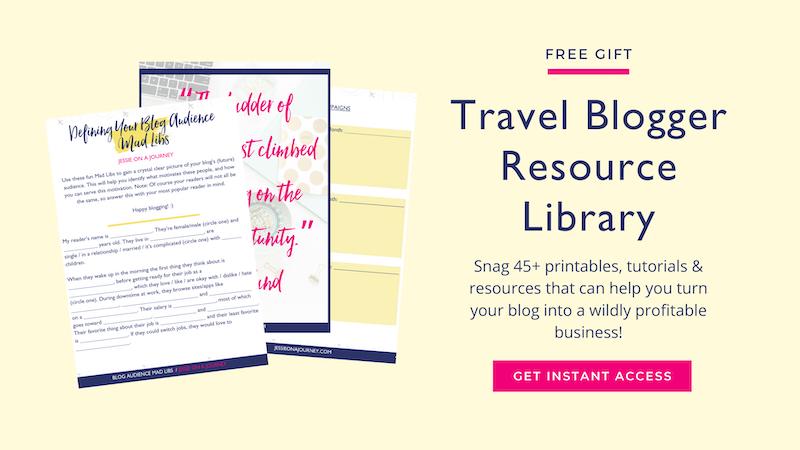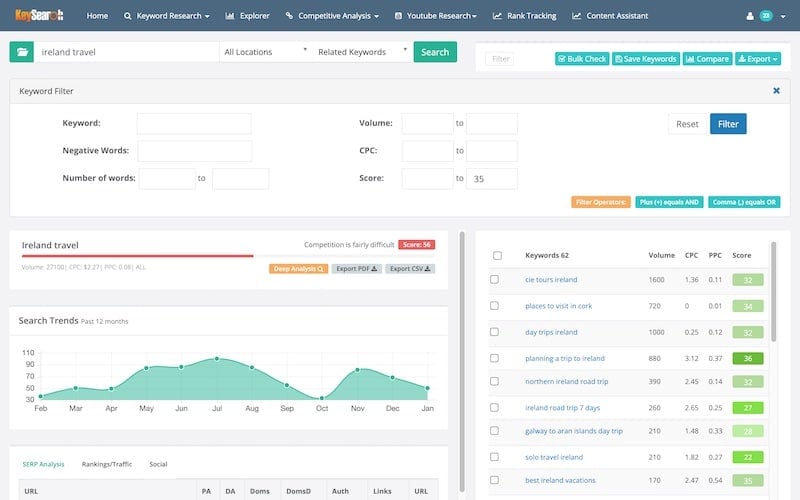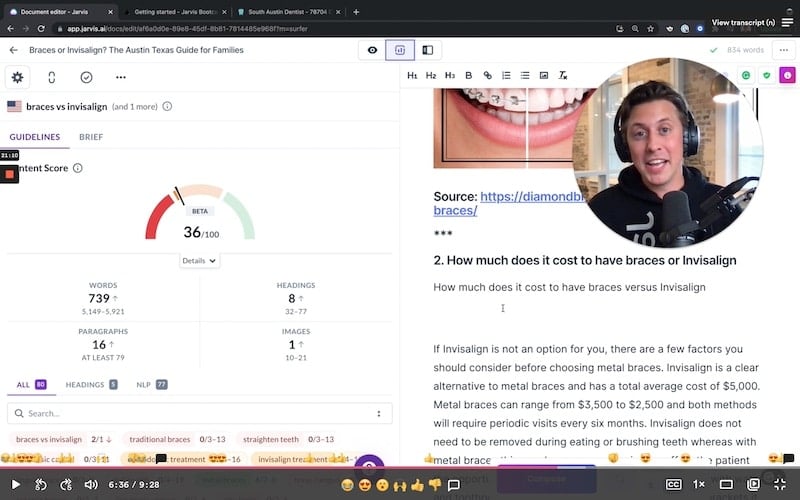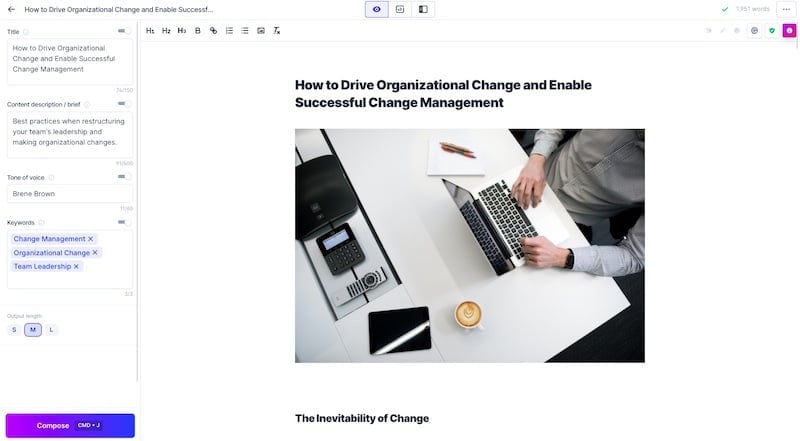How To Write Blog Posts Faster: 13 Powerful Tips For Quicker Content
By Jessie Festa. This post on how to write blogs faster contains affiliate links to trusted partners!
Curious how to write blog posts faster?
Then you’re in the right place!
As bloggers, one of our most important jobs is creating great content.
The thing is, it’s hardly our only job, so the more efficient we can be with writing articles and crafting social posts, the more time we’ll have for our other important projects.
Luckily, there are ways to seriously speed up the content creation process — which we’ll be going over below, with bonuses to help with implementation.
Grow Your Blog Faster & Easier With My Free Resource Library
But first, before we dive into how to write content faster and creating amazing blog articles, I want to invite you to grab access to my free Travel Blogger Resource Library.
The library includes 45+ blogging resources like printables, video tutorials, and workbooks that can help you grow your traffic, community, and income faster and with less overwhelm!
One particular resource I want to point out that can help you understand how to organize blog posts and achieve fast article writing is the Content Creation & Promotion Workflow Trello Board — which can also help you better promote your content for maximum engagement.
Additionally, the resource library also includes a Blog Post From Scratch Template that can help you create SEO-optimized content from start to finish.
Click here to grab the free Trello board as well as the full suite of blogging resources.
How Long Does It Take To Write A Blog Post?
In terms of how long it takes to create content, it really depends on your unique strategy and how much research is involved in creating the blog article.
If you’re writing an article that involves interviewing sources, it could take a week or more.
However, if you’re utilizing online sources and using your own knowledge, you can certainly pinpoint how to write a perfect blog post in one hour — especially if you utilize the resources below.
Write Articles Faster With These Powerful Resources
One of the easiest ways to create faster content is to utilize tools that take some of the workload off of you. We’ll go over these more below, though a few of my favorite time-saving blogging tools include:
Jasper AI (link includes a 10,000-word free trial). If you’re curious how to write a blog post in 20 minutes, the answer is artificial intelligence — which is what Jasper uses to help you come up with article ideas, create outlines, and craft quality content.
Surfer SEO. This tool is like employing an SEO expert on your team (without the 4-figure monthly price tag). You’ll get specific recommendations tailored to your blog for how to optimize your blog posts for SEO and rank in organic search results. You can see my video tutorial here, too:
Canva. This drag-and-drop graphic design tool makes it easy to create stunning social media graphics, presentations, marketing assets, and more. There are over 400k templates to choose from, not to mention an enormous library of stock photos and videos to use in your projects.
Storychief. Create, tweak, and blast your story out across all of your channels and platforms from one dashboard — in-depth analytics included.
MacBook Air with M2 Chip. In my opinion, this is the best laptop for travel blogging.
Keysearch (snag 30% off with code “jessieonajourney30”). This powerful keyword research tool makes it easy to find keywords you can rank for and optimize your content to rank in organic search. Here is a quick tutorial showing how I use Keysearch to grow my traffic:
How To Write Blog Posts Faster
Okay, now let’s dive into a few powerful tips for how to write a blog post quickly — and how to create content for social media faster, too.
If you have your own strategies for how to write articles fast, please leave them in the comments below!
Tip #1: Pinpoint Your Mission & Content Buckets
One of the most important aspects of creating content quickly is understanding the purpose of your content.
My recommendation:
Start with an overarching mission — like helping women travel solo or helping families plan unforgettable US road trips — and then have about three recurring themes or content buckets.
This step is an important part of niching down, branding your blog, and becoming a full time blogger as a whole, as it helps:
- your audience understand what to expect from you
- you create a clear and cohesive brand
- your content rank in organic search as Google understands what you’re an expert on
Additionally, it helps you blog fast as you’re not starting from scratch with what to write every single time.
Tip #2: Keep A Running List Of Rankable Keywords
Sitting down to write when you don’t have a topic idea ready to go is a huge time-waster.
Personally, I dedicate one-to-two weeks each month to writing blog posts, and I make sure that when these weeks come around I know exactly what I can focus on to create content that engages my audience and ranks in Google.
Therefore, keeping your content buckets in mind, it’s wise to keep a running list of keywords you can rank for, which also helps eliminate writer’s block. You can use a project management tool like Asana for this or even a simple Google Doc.
To do the keyword research, I use and love Keysearch.
There are a few strategies I use, but one is typing out a topic idea, seeing what keyword suggestions come up, and then filtering them to find ones that are easier to rank for.
I’ll usually set the score to be 1-35 to do this, though these numbers might differ based on your unique Domain Authority. Here is a visual:
Once I have keyword ideas, I pop them into an ongoing list I keep in Asana.
This is simplifying the strategy a bit — I go over keyword research in much more depth in my Travel Blog Prosperity membership — but doing the above step should give you a bunch of ideas.
Bonus: Click here and use code JESSIEONAJOURNEY to snag 20% off Keysearch.
Tip #3: Create A Content Calendar
Building on the above, you can further save time blogging by creating a content calendar that includes your recurring topics and rankable keywords.
Pro tip:
To also benefit from seasonal spikes, you can pre-plan posts to publish a few months before they’ll be popular. This is why it’s helpful to plan an annual content strategy in advance.
For instance, if you write about adventure travel, you might publish an adventure travel gift guide in October in preparation for the holiday season. Creating gift guides for your blog, especially for this time of year, can help you seriously increase website traffic.
The reason you want to publish this content early is to give it time to rank in Google — as well as to give your Pinterest pins time to rank in Pinterest if you utilize that platform. This is an important part of any Pinterest strategy.
Keep in mind, too, that people typically research seasonal topics in advance. For example, if you write a post on fall foliage road trips, people will be researching and booking their trip before the foliage season begins.
In terms of how to write blog posts quickly, having this content calendar saves time as you know exactly what you’ll be writing and when.
Tip #4: Start With A Blog Post Outline
Creating an outline is the difference between staring at a blank screen wondering what to write and simply filling in the blanks.
Curious how to write a blog post outline? Well, there are a few ways to do.
Mind mapping
First of all, you might try mind mapping, which is an exercise where you start with a central theme that is typically circled in the center of a piece of paper.
From there, you draw lines and circles to branch out your ideas from there, and more lines and circles to branch other ideas out from those.
Here is a visual example:

Keysearch
Another idea is to use a tool like Keysearch to do keyword research, including discovering related keywords and topics that could complement your main keyword.
For example, in a post on how to monetize your blog from day one, Keysearch let me know that people were also interested in learning about how to monetize a blog without ads as well as blog monetization requirements, so I added sections to address those questions.
Again, you can click here and use code JESSIEONAJOURNEY for 20% off Keysearch if you’re a new user.
Artificial Intelligence
Another idea is using artificial intelligence — like Jasper AI (formerly Jarvis), which in itself can save you loads of time!
Here’s how it works:
- Choose the blog post outline template
- Input your topic and desired tone
- Click “generate”
Boom — Jasper will generate an outline for you that you can use for articles and other long-form content.
For a visual of how Jasper works, you can click here to snag a 10,000-word free trial and click here to check out a demo:
Tip #5: Utilize Artificial Intelligence (AI)
So I just mentioned utilizing AI to create your blog post outline, but that is hardly the only thing you can use it for. AI is truly the answer if you want to understand how to write an article quickly or create other types of content almost instantly.
For instance, Jasper can also help you save time with:
- Brainstorming blog post topic ideas
- Remember, I mentioned above it’s helpful to have a running list of blog post ideas ready to go, so this can further save time with that!
- Writing introduction and conclusion paragraphs for you
- Creating marketing copy
- Creating keyword-rich blog articles
- And more!
There are over 50 content creation templates to choose from, which you can see here.
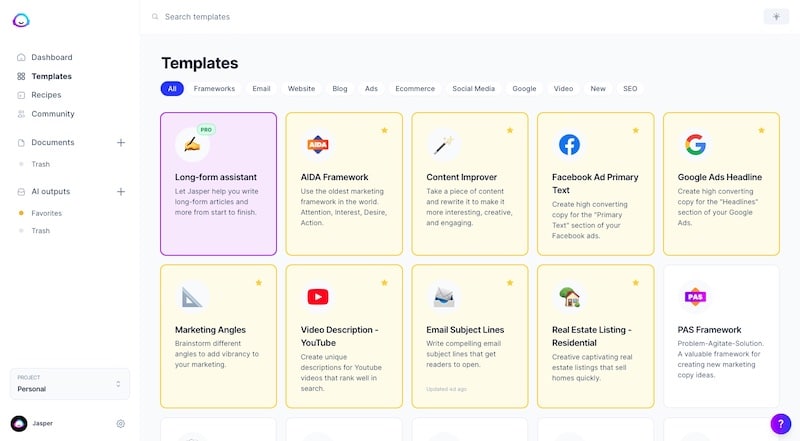
In terms of writing articles, here is a quick overview of how it works:
- Login to Jasper and choose “long-form assistant”
- Choose “blog post workflow”
- Let Jasper know what type of content you’re trying to create as well as your main keyword
- Jasper will then generate title ideas and sample introduction paragraphs
- Choose which ones you like and then open the long-form editor
- Choose to have Jasper create your content or input subheadings and have Jasper craft copy to go into your various sections
Just keep in mind that while Jasper does create content, it is best used as your assistant; as in, you’ll still want to fact check, add in supporting case studies and facts, and refine the article to add in your own personality, voice, and knowledge.
Again, you can snag a 10,000-word free word trial by clicking here.
Tip #6: Automate Your Search Engine Optimization (SEO)
An important part of content creation is Search Engine Optimization (SEO), though doing this research can be tedious and time-consuming.
Luckily, Surfer SEO speeds up the process and helps you create content much faster. Instead of simply giving you data about other sites that are ranking, Surfer SEO analyzes your website to make tailored recommendations for:
- specific keywords to target
- specific ways to optimize new content
- specific changes to make to old content to improve its chances of ranking
- specific missed opportunities for internal and external backlinks
- specific on-page SEO optimizations (such as optimal word count, title length, image count, etc)
- and much more
As you can see, the tool gets specific!
In short, you’ll get a step-by-step SEO workflow that can help you grow your traffic and increase your rankings faster — no guesswork required!
In case you didn’t see the Surfer SEO tutorial above, here it is again:
Bonus:
While you’ll want a paid plan to access all of the features in the tutorial (I have the Pro Plan), they do offer a free AI Article Outline Generator to help you get acquainted with their platform.
Totally confused by SEO? Check out their free SEO Writing Masterclass!
Tip #7: Have A Structure For Regular Story Types
While each blog post I publish is unique, I’m often writing the same types of articles — like solo female travel guides, hiking guides, NYC neighborhood guides, and show notes for The Profitable Travel Blogger Podcast.
I don’t reinvent the wheel each time. Instead, I reuse the same headings for each, with a few tweaks depending on the exact post topic.
For instance, if I’m writing a solo female travel city guide, I know I’ll always include headings like “things to do for solo travelers” and “safety tips for solo travelers”. Additionally, I’ll always promote my free 5-day solo female travel course opt-in freebie.
Tip #8: Save Blocks In Gutenberg
Gutenberg is the drag-and-drop blog post editor most WordPress bloggers use. One of its neat time-saving features is that you can save blocks to reuse in other posts.
This is incredibly helpful if you find yourself constantly adding the same sections to your articles.
For example, as a travel blogger, I add hotel recommendations, tour suggestions, and a travel insurance section in almost every blog post. Instead of writing these from scratch every time, I can insert my Hotel Recommendations block from Gutenberg and edit it to fit my current article.

Tip #9: Create A Content Creation Checklist
In terms of how to write blog posts quickly, this is a big one! A content creation checklist can save you a ton of time.
Instead of wondering what steps you should take each time you write an article, you can quickly refer to a written list of steps — which also means you won’t forget any.
The steps can also help you create your best blog posts, as you’re not wasting precious brainpower trying to remember what you need to do before you hit publish.
For instance, a few steps on my personal blog post checklist include adding an opt-in freebie (like these clever opt-in offer ideas), promoting relevant affiliate links, and creating a backlink profile to help my content rank in organic search results.
Bonus:
You can find a Content Creation & Promotion Trello Board within my free Travel Blogger Resource Library — which you can copy into your own Trello account.
Tip #10: Write Without Stopping.
Yes, research and editing are important parts of writing a great blog post; however, if you’re constantly pausing to look up facts, it’ll be hard to get into a flow state.
Hone your creative storytelling skills and craft truly engaging content by first getting all of your ideas out. Let the writing flow from your fingertips, and just mark spaces you’ll need to go back to later.
Personally, I make text that I need to fact check purple, and write “XYZ” in spots that I need to fill in later. This makes it really easy to go back to these areas that need attention once I’m ready to edit, and helps me create content much faster.
Tip #11: Repurpose Long-Form Content For Short-Form Mediums
If every time you post on social media you’re starting from scratch, you’re going to love this time-saving tip!
Instead, start with a piece of long-form content — like a blog post, YouTube video, or podcast episode — and then pull out the most interesting points. Each of these points can be its own social media share!
For instance, if you write a post on fun things to do in NYC, each of those fun things could be a unique social share that you reformat to fit each platform.
Moreover, you can often reuse the same social content across platforms — like TiKToks, Reels, and YouTube Shorts.
If you’d like to dive into this idea further, check out my video sharing a strategy for a streamlined blogger workflow:
Tip #12: Create Across Platforms From One Dashboard
Logging into your various accounts individually to create and analyze content can be a big time-waster.
That is why using a tool like StoryChief can save you time by bringing all of your platforms into one workspace — with in-depth analytics included.
In short, you simply click “craft a story” to create your blog post. You’ll also be able to add media — including from Instagram, which can be a huge time-saver — and invite collaborators.
(Because, remember, growing your blog through collaboration can be powerful and can help you see success faster!)
Once your article is ready to go, you can quickly and easily share it across your various digital touchpoints, like your blog, social media platforms, email list, Medium, and more.
There are other time-saving features, too, like guided SEO copywriting assistance, a digital content calendar, and social media scheduling.
Tip #13: Have A Repeatable Promo Plan
Just as you should have a repeatable blogging workflow for creating content, you should also have a content promotion checklist to save time with getting your posts seen.
Part of this workflow should also include having plug-and-play templates ready to go for social media. For instance, if you have a Pinterest strategy, you might create and save pin templates in Canva — a drag-and-drop graphic design platform — to reuse for each post.
Moreover, a TikTok for bloggers strategy might involve breaking up articles into recurring vertical video types.
Again, you can find a Content Creation & Promotion Trello Board within my free Travel Blogger Resource Library to use for yourself.
Tip #14: Create A Productivity Strategy
There are so many tools, techniques, and tips for enhanced productivity — from intuitive eating to working in batches to creating a mindful morning routine and beyond.
One productivity method I personally love is the Pomodoro Technique, which is a time management system that involves breaking your day up into chunks. It looks like this:
- Choose your task
- Set a timer for 25 minutes and work on the task
- Take a 5-minute break
- Repeat, taking a longer break of 15-30 minutes after 4 pomodoros

Another tip: let go of perfectionism.
While striving to create quality content is important, if you spend hours, days, or even weeks agonizing over every detail of a post before you hit publish, it’ll hold you back from being efficient and sharing your voice with the world.
An Important Note On How To Write A Quick Blog Post
While researching how to write a blog post fast can help you discover strategies like the ones mentioned above, the goal shouldn’t be to just churn out post after post.
If you’re wondering how to write a great blog post in just 15 minutes, the truth is creating thorough and engaging content takes time and research. Sure, you can use AI to write blog posts almost instantly; however, you’ll still want to spend time refining that content and giving it a human element.
My recommendation:
Optimize your workflow — but also enjoy the process! Your passion for your topic should shine through your content so that your audience is also excited and feels like when they read your posts they’ve learned something.
This is truly one of the most important aspects of creating a profitable blog!
Also, along with creating new content, make sure to update old blog posts, as this is a vital part of having a healthy SEO-optimized website.
A Simple Step-By-Step Blog Writing Formula
Okay, now that we’ve gone over how to write blog articles fast, let’s go over a simple process for how to write a unique blog post while applying some of the above tips.
Step #1: Start with your blog post topic. It should be related to your mission and should be within one of your main content categories to maximize it’s ability to rank in organic search results.
Step #2: Do keyword research. You can use a tool like Keysearch to research what keywords and topics should be included for an in-depth keyword-rich article. Remember that code JESSIEONAJOURNEY saves you 20%.
Step #3: Create your blog post outline. This helps you create a fill-in-the-blank template for writing your content faster. Keysearch and Jasper (free trial link) are both great tools for quickly and efficiently crafting a great outline, though you can also use a free tool — like mind mapping.
These tools can also be helpful as part of a podcast workflow if you have a show where you script episodes.
Step #4: Create your content. To maximize efficiency, consider utilizing producitivty strategies like the Pomodoro Technique and task batching.
Moreover, save time by reusing content templates, having a reusable content checklist saved, and employing the powers of artifical intelligence through a tool like Jasper — which can actually write out your content for you (though make sure to edit it for a human touch).
Here is a look at the long-form editor in Jasper:
Step #5: Edit, fact check & add in missing content. Remember, on your first run you just want to get into a flow state and write. Afterward, you can fill in any necessary blanks.
Step #6: Promote your content. Having a content promotion checklist that outlines your repeatable promo workflow will help you save time with this.
How To Write Articles Fast (Bonus Resources)
The following guides can help you create content faster and aid in the blog writing process:
How To Create A Profitable Content Plan In 3 Steps (free workshop)
How To Start A Travel Blog & Make Money
How To Create A Blogging Content Calendar
120+ Travel Blog Post Ideas For Creating Engaging Content
A Streamlined Workflow For Organizing Your Blogger To-Do List
9 Clever Ways To Increase Blog Traffic (Beyond SEO)
How To Map Out & Crush Your Blogging Goals
How To Create A Travel Blog Business Plan
How To Get Blog Followers & Grow Your Blogging Business
How To Create A Pinterest Strategy That Grows Your Blog Traffic
12 Quick-Win Strategies To Grow Your Blog Fast
What would you add to this guide on how to write blog posts faster?




